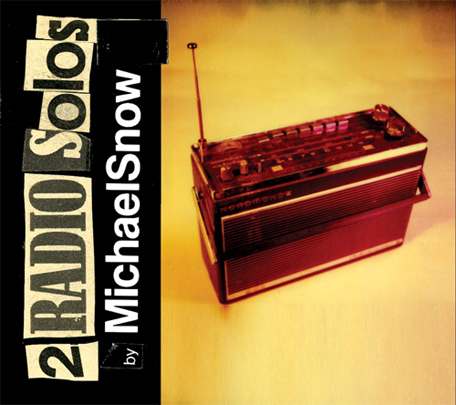
73 minutes of play, cardboard sleeve, full colour, 14cm x 12.7cm

In conjunction with the 2009 exhibition awashawave, curated by Christof Migone, the Blackwood Gallery has rereleased Michael Snow’s Two Radio Solos. Originally released as a cassette in 1988, the two pieces have been re-mastered for release on this CD.
“These 2 short-wave pieces are both "played” continuous improvisations. There was no editing, no post-facto electronic alteration. The sounds were found by paying intense attention to fate tuning in and out and between stations, changing bands, bass, treble and volume. The radio played is a circa 1962 Normende (pictured). The gradual change in pitch and speed on SHORT WAVELENGTH is an "accident": batteries were losing power during the recording. The tapes were made at night in a remote North Canadian cabin lit by a kerosene lamp......................” –Michael Snow, on back of CD
“The radio signals of shortwave frequencies featured in Snow's Two Radio Solos manifest a veritable cornucopian palette of sounds in these lengthy tracks (titled "Short Wavelength" and "The Papaya Plantations"): pulses, beats, cracklings, hisses, tones, ethereal emanations, saturated groundswells, a Babelian assortment of voices, music of various genres, and noises of all stripes. Their complexity and countless number are foregrounded by Snow's acute listening and fine tuned improvising. He animates these densely populated frequencies from an isolated location—the solitary player in a cabin tuning in the multitude.
Two Radio Solos presents a forest of unintelligible sounds with brief moments of recognition; the signs are sporadic amidst the awashed soundscape.”
–Christof Migone, excerpted from the press release for Two Radio Solos (2009)
Graphic Design: Original: Michael Snow, CD version: Graeme Laird
Remastering: Christof Migone
Pressing:
MMS (Toronto)
To order any of our publications, please send an email including title(s), number of copies, and your mailing address to: alison.cooley@utoronto.ca
A 20% discount is available to students and members of the Ontario Association of Art Galleries.
This release is as much an artefact in time as it is a musical presentation. The image of Michael Snow sitting in a kerosene lamp-lit cabin in northern Canada scanning the shortwave band is something that is quintessentially of this country. The signals are further altered by a cassette recorder whose batteries are running down, providing the only semblance of "post-production" that manifests in this distinctly primitive scenario. Sounds range from voices and music from around the world phasing in and out of the air, combined with the static-laden, whining frequency shifts that warp with every slight turn of the dial. This way of creating can only be achieved with the analog dial — no digital manipulation here. The charm of this release is the chance aspect of the act. Snow couldn't have known what would appear as he tweaked the dial but shows his improvisational skill by knowing when to stay on, leave or modulate each of the frequencies he happens upon.
-Nilan Perera, Exclaim Magazine, July 2009
The great thing about cassette releases in the 1980s was the fact that you could do anything, then release it and still no money, no risk was involved. The radio was a popular instrument back then. Context from Germany released 'Schnitte', a collage of radio sounds cut into a thirty minute work. To mention an example not on the press text. Micheal Snow released 'Two Radio Solos' as a cassette in 1988 on Freedom In A Vacuum, and its now re-released on a CD and I may wonder why. Maybe Snow has the potential to sell CDs? Why not stick to the old cassette format - these days a hipper than hip thing? The do-it-yourself musical approach probably comes best alive when using a radio. No more three chords, or one for that matter, just dial the knob on a radio. Anyone can do it, most likely everyone should do it (impossible with all these automatic channel searching these days), but no one should release it, in its pure form on, CD anymore. That was done in a time when the format fitted the music, but not the CD. Or perhaps I have just an old-fashioned idea about CD releases; that might actually be true also. Its nice to play for the entire seventy-seven minute, but perhaps I like to hear something done with the radio sounds.
-Frans de Waard, Vital Weekly, May 2009